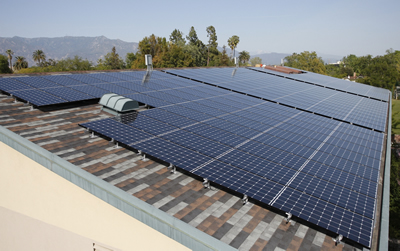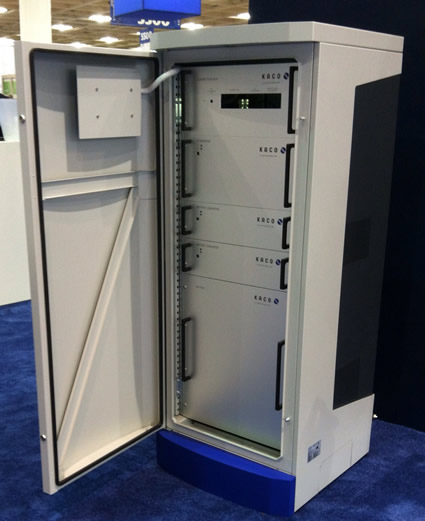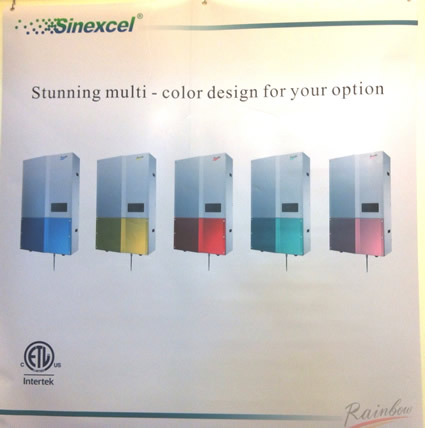Welcome to the
Run on Sun Monthly Newsletter

In this Issue: |
July, 2012
Volume: 3 Issue: 7
Non-Residential PACE Rebounds -
|

PACE Could Spawn Lots More of This! |
Residential customers are still out in the cold, but for non-residential property owners the situation, at least in LA County, is far more promising and this may be just what is needed to get commercial and non-profit building owners into the game. The basic idea is this: any property owner who pays a property tax bill - including non-profits like private schools - can participate. They hook up with a funder - Wells Fargo is actively participating, for example - and the County issues a bond to that funder in exchange for the proceeds to fund the project. The property owner then pays off the bond by a property tax assessment that "runs with the land" so it is not a personal obligation of the property owner.
Part of the beauty of this program is its flexibility. The funder and the property owner reach mutually agreeable terms for the project including interest rate and payback period. (Indeed, we see this as a great way for a SunCorp to assist a non-profit entity in going solar.) The County simply determines that the proposed project qualifies for the program and then acts as the bill collector.
There are requirements for participation, but they are not particularly onerous:
- Applicant must be the legal owner of the property, and all of the legal owners of the property must agree to participate
- Mortgage holder(s) must explicitly consent to the PACE assessment in writing
- Property owner must be current on any existing mortgage(s), property tax and assessment payments
- Property owner must not have defaulted on the deeds of trust
- Property must not be subject to any involuntary liens or judgments
- Property must not have been delinquent on property taxes for the past five years
- Property will be subject to the appropriate jurisdiction’s permitting inspections and all other applicable federal, state, and local codes and regulations
- Property owner must not be in bankruptcy and must not have declared bankruptcy within the last 10 years
Notably, there are no program requirements regarding equity in the building (although the funder may impose some) or other financial hurdles. The program can finance up to 100% of the project cost, including engineering reports and permit fees. To qualify, the building must either be in the unincorporated areas of the County or in one of the 79 cities (some 90% of the County) that have approved the program.
The County is actively trying to get the word out to building owners throughout the region. They have launched a website, and will be offering an outreach meeting for interested contractors sometime in August (we will post the details when we have them). In the meantime, you can request more information by emailing them at: pace@ororkeinc.com.
“The program can finance up to 100% of the project cost, including engineering reports and permit fees…”
Help Us Spread the News!






InterSolar 2012 RecapWe spent the first part of the month at InterSolar North America 2012 and here are our reactions to the show, in no particular order, some good, some bad and one really pretty ugly... IS ≠ SPIThis was our first exposure to InterSolar; previously we had passed on the show in favor of Solar Power International (which we have attended every year since 2006). But this year SPI is all the way out in Orlando, so barring another miracle, we will likely have to give SPI a pass. InterSolar, on the other hand, was close at hand in one of our favorite cities, San Francisco, so we decided it would be a more cost-effective alternative. That it was, although we almost paid a high price indeed by taking a way-too sketchy route to the convention center Monday evening! Lesson learned, we stuck to safer, saner routes the rest of the week without incident. The biggest difference between InterSolar and SPI was in who was there and, more importantly, who was not. It seemed that every time we searched for a particular manufacturer, they weren't to be found. For example, missing in action was: LG (whose panels we discovered at last year's SPI), Sanyo/Panasonic, and Enphase Energy (though we did run into a number of their key personnel). This was beyond frustrating since the biggest point of the show is for us to reconnect with companies that we have worked with in the past to learn about their upcoming product lines. Oh well, that's what you get for not paying the big bucks for SPI! Buzz WorthyDespite that disappointment, there was still plenty of buzz around the show. Revenge of the MicrosHighest on the buzz meter at the show was the plethora of microinverter/DC-DC converter/optimizer manufacturers on hand. This was made all the more intriguing given that the king of the microinverter hill, Enphase, was not in the house. (I was told that they have never exhibited at InterSolar NA.) Even long-time micro opponent, SMA, was there, touting - if you can call it that - their new microinverter. Indeed, in what has to be the most reluctant product launch of all time, SMA had its micro on display (alongside inverters ranging in capacity all the way up to hundreds of kW). Imitation is, indeed, the sincerest form of flattery and Enphase must surely be blushing. No doubt, SMA will be around a long while (with or without a microinverter offering) but it is hard to see all of these other players surviving. (As one distributor who carries Enphase now told us, it is really hard to see the value in adding another microinverter line to their product card.) It will be interesting to see how this shakes out over time. We did learn that prominent, Las Vegas-based installer, Guy Snow, is presently conducting his own temperature performance testing between various microinverter lines. We are hoping that he will share his data with us when his study is complete. Storage on DisplayEnergy storage - more for load shifting/shaving than for off-grid use - was another hot topic floating around the hall.
Party HeartyA solar conference requires opportunities for the solar tribe to hang out and party hearty and InterSolar was no exception to that rule. Quite the contrary, there were numerous chances - on the conference floor and in a variety of nearby venues - for the faithful to raise a toast, honor the memories of our fallen friends, and lubricate the formation of new friendships. Beyond a doubt, the folks in the Schletter booth win the award for hospitality - whether offering the best coffee on the floor each morning (along with some tasty pretzels) or the seemingly endless supply of good German brew that appeared each afternoon, they really managed to meet the needs of the crowd (and boy did they draw crowds!). Our solar Tweet-up was a big hit - but boos to The Thirsty Bear which for some reason was unable to seat us all in the same vicinity. For me, the most touching moment of the week was during the Solar Battle of the Bands, when tributes were made to our dear friend, Heather Andrews, and others who have died in the past year. Solar needs all the advocates it can get, and this was just another reminder of how great a loss Heather's passing was, and how deeply that loss continues to be felt. Just Plain FailEddie are You Kidding?Sometimes shows like this reflect the humor level of a barely pubescent boy. Nowhere was this more on display than on the third floor amongst several of the racking vendors who couldn't seem to resist making multiple jokes about racks. As in: "Heh. Heh. He said, 'racks'. Snicker." (This amidst images of a busty woman doing improbable things with an L-foot. Or some such.) Seriously? And then people wonder why there aren't more women in solar. Hint - dropping the sexist humor would be a good start. Count Me OutAnd then there was Fire Energy, a solar distributor that has a facility in nearby Chatsworth. Always eager to find local supply sources, I asked them about what they stocked. All kinds of things, I was told by the eager salesrep. Well, what about Unirac, do you stock that? "Yes," she said, "but it is generic Unirac." "What," asked I, "is generic Unirac?" "It is product that we have made for us in China, designed to be as close as we can make it to Unirac's products without interfering with Unirac's copyrights [sic]." Wow. So your business model - of which you brag to a total stranger - is to rip off your competitor's designs and build them cheaply in China and you want me to endorse that strategy? Sorry, not interested. I suppose it is a sign of the, ahem, maturity of an industry when it can exhibit all the same faults and foibles as any other mature industry, including trade disputes or infringement actions. It may mean we are reaching maturity, but these sorts of actions are not what the solar industry is supposed to be about. Come on, folks, we can do better! |
Power to the People - Support SB 843!Solar installations are sprouting up almost everywhere - and California leads the Nation with the most installed solar capacity. That's the good news. The bad news is that not everyone who would like to add solar, can. Eco-minded renters, for example, are excluded - but so are homeowners who would love to put solar on their homes but have sites that are too shaded to be viable. (Believe me, here in shady Pasadena we know all about that!)
For example, let's say a typical Pasadena homeowner needs a 7kW system to offset their usage whereas a renter needs 1.5kW and a local small business needs 20kW. A solar developer builds a 200kW system (maybe on a warehouse roof) and could sell corresponding shares to 8 homeowners, 16 renters, and 6 small businesses. Everyone gets what they need - with no concerns about local shading, or roof ownership, or even leaking roofs! This fabulous innovation in how solar is deployed could really take the lid off solar installations and greatly expand the universe of people who could "go" solar - even if they couldn't install solar. Indeed, one study asserts that providing this innovation in California alone would create 12,000 jobs, generate $7.5 billion in economic activity and generate $235 million in sales tax revenue by 2019! And it would do this without any additional public funding. Talk about a win-win! But we aren't there yet. There is a bill pending right now in Sacramento - SB 843 - that would make this type of community solar legal amongst the State's three investor owned utilities: PG&E, SCE and SDG&E. And that's where YOU come in. You can show your support for this innovative program by contacting your legislator NOW and ask them to support the bill. Our friends over at Vote Solar have made this very easy - just click on this link. (If the link doesn't work right away, please try again later - this is too important to miss out on adding your support.) We will be tracking this legislation and will update you on its progress. |


